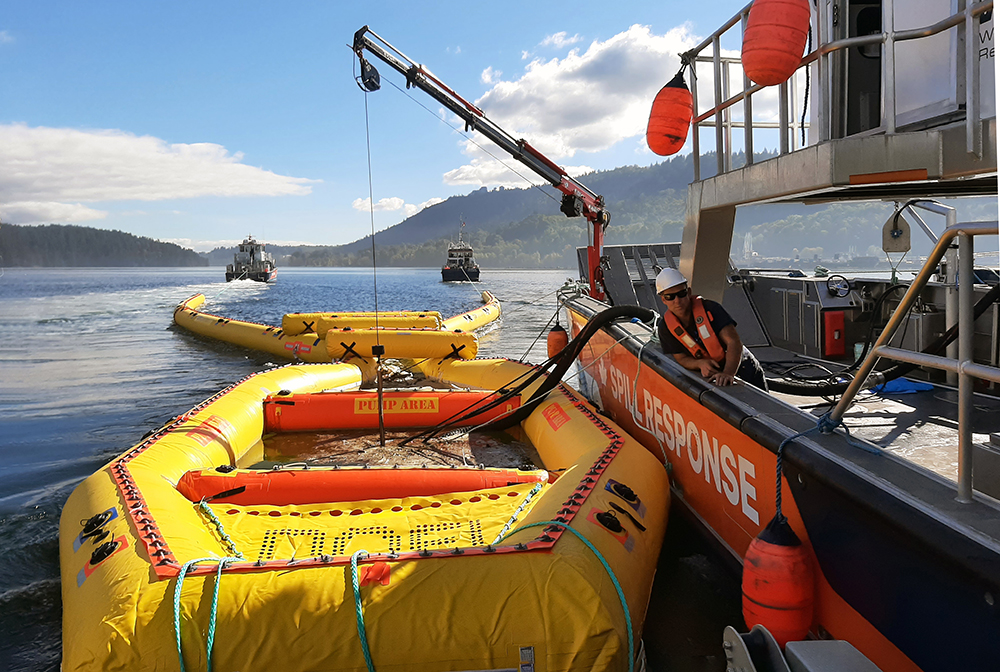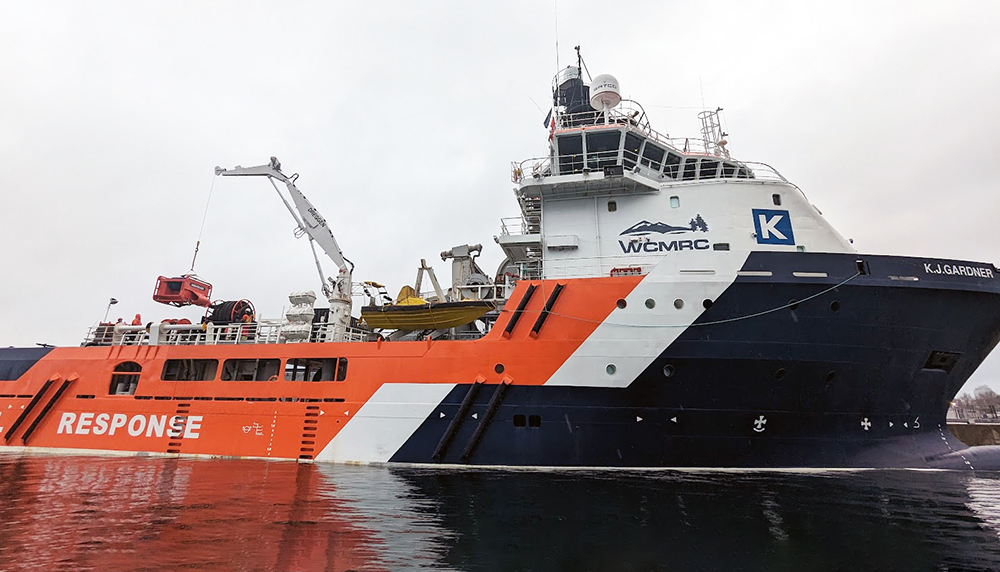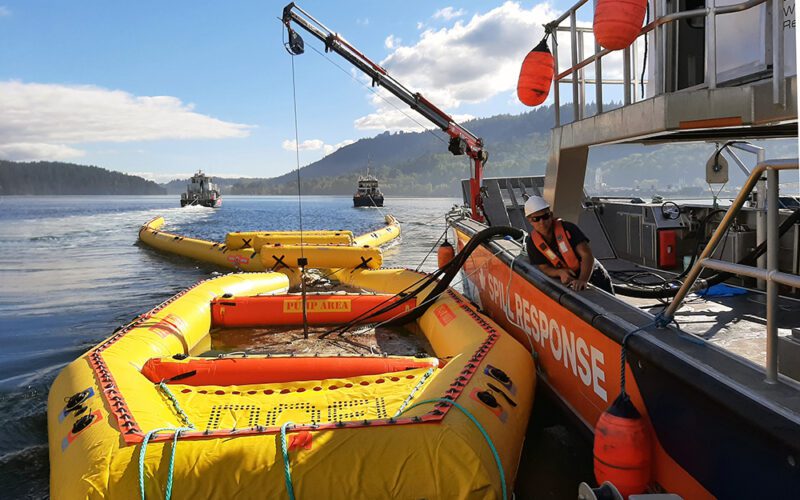
From difficult weather conditions to the state of a location in the aftermath of a disaster, a number of factors come into play when an oil spill occurs.
And while many of them are out of one’s control, experts in this field know that one of the factors they can control is the ability to quickly respond to a spill.
“The faster you can get there, the quicker you can contain it and the more likely you can mitigate the impact of the damage of that spill,” said Michael Lowry, a spokesman for Western Canada Marine Response Corp., an organization certified by Transport Canada and funded by more than 2,300 industry members. “For us to be able to respond to spills within six hours as opposed to 72 hours … that’s a massive improvement.”
In recent years, many companies and organizations have been looking at and investing in technology to gain an edge in response time and recovery, enhancing their capabilities and learning from spill disasters of the past, including the 1989 Exxon Valdez oil spill in Alaska that leaked more than 11 million gallons of oil into the ocean or the 2010 Deepwater Horizon spill that occurred after a drilling platform exploded in the Gulf of Mexico.
Geoff Taylor, an Unmanned Aircraft System (UAS) program manager with Moran Environmental Recovery (part of the group of companies that includes Global Diving and Salvage), was hired in April to help facilitate development of Moral Environmental’s UAS program.
He said his counterpart at Global Diving is overseeing underwater remotely operated vehicle (ROV) development, while another sister company, VacSol, is overseeing the development of ground-based systems.
“It’s kind of a tertiary approach of integrating aerial, underwater and surface robotics and new technologies in order to increase our reach and capability and safety and efficiency across all possible domains,” Taylor said.
The development of the program is still in its early stages, which includes the acquisition of assets and plans for equipment training, Taylor said.
“My focus has been really building the foundation of this program as a whole in order to become more of a service for day-to-day operations,” he explained.
Rapid Response
John Bradley has seen first-hand the technological evolution of spill response. In 1996, he founded H2O Environmental, a 24-hour emergency response company serving 14 states in the Western U.S. He introduced the use of drones about a decade ago, which at the time was a fairly new offering in the marketplace.

After selling the company to the environmental waste firm Clean Harbors in 2019, Bradley and his partner Corey Mecham started Rapid Response Systems, which specializes in providing clients with digital emergency response plans using various technologies such as high-resolution photogrammetry, advanced thermal imaging, live video streaming and push-to-talk capabilities.
“We’re bringing digital response solutions into the marketplace because they don’t exist, and they should because (the) technology is there, and especially with Elon Musk’s (Starlink) satellite system, you can now move digital material to and from operational sites, meaning I can bring any digital material to an operational site and take digital material and move off that site,” Bradley said.
Rapid Response incorporates Starlink technology as part of its communications system offerings, a game changer for responders who could not send or receive information because of overloaded cellular networks, especially in remote areas.
Starlink also helps to bring together communications, turning cell phones into push-to-talk communications, Bradley added.
“I can find out about an incident and can give you live video in the middle of the remotest location you can imagine,” he said. “I can bring in experts that aren’t on site and they can see exactly what’s happening.”
The use of drone technology is also a big part of Rapid Response’s services.
“Most people just take a single picture or they take a video and bring it back; we don’t do that,” Bradley said. “We take 500 pictures (and) we stitch them together into a big map. You can draw a line on our map and it’ll give you measurements that are within two centimeters of accuracy of measuring inside our map. And that’s not an old map—that’s the current situation.”
Rapid Response is also incorporating AI chatbots for task-oriented activities, such as mass digital communications.
“People are scared of using AI, but we’re not using it to make decisions; we’re using it to formulate lists that are more correct and interpret data quicker,” Bradley said.
To Bradley, it means more time to focus on better planning, operations and prevention.
The Spill Control Association of America, whose membership includes response contractors, manufacturers, distributors, consultants and other stakeholders on the West Coast and elsewhere, has long discussed the latest use of technology in spill response.
Some of the emerging technologies involve digital response strategies, such as robotics, unmanned aircraft systems and drones, the types of devices used to help with obtaining and analyzing data acquisition as it is happening and digital mapping the environment for rapid integration as the spill moves, the association said.
For example, these devices offer instant situational maps, live video and immediate feedback to offsite and ground personnel.
The technology, which is still evolving, could be leveraged more, according to the association, adding that more education is needed to determine what’s possible and how to be able to use it in an effective manner.
The association also pointed to the environmental and social aspects of spill response, which has changed in the last five years, especially with the emphasis on carbon footprints.
More companies are implementing biodegradable and reusable products for spill cleanup, an offering that has gone from being buried at the bottom of the list of features to the first bullet point, according to the association.
“We at the Spill Control Association of America prioritize response equipment and technique advancement,” said Angie Martin, the president of SCAA and a senior vice president at Heritage Environmental Services. “We believe that these advancements protect the environment as well as the health and safety of the general public and our employees.”
She added that the organization works hand-in-hand with many government agencies such as the Environmental Protection Agency, the U.S. Coast Guard, the National Oceanic and Atmospheric Administration and the Bureau of Safety and Environmental Enforcement, to share information and best practices.
Canadian Efforts
In Canada, various efforts are underway in the public and private sectors to improve oil spill response and recovery.
In November, the University of Northern British Columbia announced that its engineering professor, Jianbing Li, has received more than $830,000 in funding over four years from the Canadian government’s Multi-Partner Research Initiative (MPRI) to advance his scientific research on marine oil spill response.
Li is working to develop “next-generation decanting technologies” for separating on-site oil and water and disposal. His was one of 10 projects to garner funding from the MPRI, which launched in 2018 to ‘nurture’ private and public sector partnerships on oil pollution solutions. Li previously won funding from the program in 2019.
“Our lab has been developing and testing improved oil/water separation and wastewater disposal technologies under different spill conditions,” Li said in November. “This funding will greatly help us to advance our oil spill response solution through technological innovation and multi-partner collaboration.”
His work is centered around creating innovative ways of pulling oil from water with equipment already on a vessel so that the decontamination process can be done solely on site and allow water to be cleaned and returned to the ocean, making spill response more sustainable and cost-efficient, according to the university.
“The results of Dr. Li’s innovative research will help protect Canada’s environment and coastal communities and sets an example for oil spill response worldwide,” UNBC President Geoff Payne remarked. “Support from the federal government will allow UNBC to continue to leverage its environmental engineering expertise to mobilize knowledge for local and global change.”
Experts say that spill response and recovery are expected to become more significant as additional vessels expand in size.
In the last few years, Western Canada Marine Response Corp., which works on an average of 20 spills annually on the Canadian West Coast, has seen a multi-million-dollar investment in equipment, new response bases and personnel in anticipation of the Trans Mountain pipeline expansion. The project seeks to twin the current 1,150-kilometer pipeline to and from Strathcona County (near Edmonton), Alberta and Burnaby, British Columbia.
The expanded system would increase from about 300,000 barrels to 890,000 barrels daily, according to Trans Mountain.
“They’re about to be finished twinning that line, which means there’s going to be a lot more tanker traffic,” said Lowry, of Western Canada Marine. “On the Canadian side, it’s going to be a seven-fold increase in Canadian tanker traffic.”
The $170 million expansion includes adding six new response bases, doubling the size of its fleet from 44 to 88 vessels and increasing the number of full-time staff to more than 200 employees, mostly mariners, Lowry said.
They include state-of-the-art skimming vessels attached with infrared cameras so operators can see the heat signature of oil at night, giving the firm enhanced nighttime operation capabilities.
They also include three new Robert Allan Ltd. custom-designed coast response vessels that can handle heavier weather on the coast.
The first two Robert Allan Ltd.-designed barges, Sentinel 303 and Sentinel 304, arrived in Canada in 2022. The 3,500-metric ton oil spill response barges feature spill containment systems with four unsheltered booms housed in containers with Current Buster No. 4 and Current Buster No. 6, hydraulic reels and general-purpose boom. They also contain storage space for absorbents, mission-specific containers and decontamination gear, according to the company.
The barges feature a pair of small vessel docks stored onboard and can be used on port and starboard sides to help responders get in and out. It helps them transfer recovered oil from response vessels to response barges, the company said. There’s also a Desmi Terminator skimmer and hose reel to help remove oil floating on the surface and a Norcrane fixed-boom crane to help handle gear and hoses, the company added.
There have been significant improvements in the design and function of oil response and recovery equipment, Lowry said.
On the skimmer side, companies like Aqua-Guard Spill Response Inc. have made efficiency improvements in the aftermath of the Deepwater Horizon incident.
“We’ve seen the efficiency of skimmers go from maybe collecting 70% water and 30% oil to almost the complete opposite,” Lowry said.
Last November, Aqua-Guard, based in North Vancouver, B.C., announced that it has been selected as a finalist in Natural Resources Canada’s “Oil Spill Response Challenge” and is expected to receive up to $1 million to further develop a proposal to “mechanically recover floating oil sheens with unprecedented high oil/water efficiency.”
The company has moved on to Stage 3, which gives Aqua-Guard and the other finalists a year to scale and demonstrate their concepts. The winner receives a $2 million prize.
“Aqua-Guard, after significant progress in Stage 2, is working to develop a scalable solution that can be integrated into our RBS TRITON oil skimming systems that have been supplied worldwide over the past 30-plus years,” CEO Cameron Janz said in November. “This advancement is looking to fill a major gap in oil spill response, enabling recovery of both thin layers and thick oils with unprecedented efficiency and capacity.”
The use of drones is also starting to make an impact for Western Canada Marine, Lowry said.
“It’s a lot easier for us to kind of identify the slicks and chase them down and recover them, because the vessel captain can see exactly where they are in relation to the oil,” he remarked.
The firm also has been developing a comprehensive mapping tool that would allow it to pre-identify areas on the coast that are particularly sensitive to a spill, while also considering environmental, First Nations and economic issues that could affect marinas and ports, Lowry said.
“We can develop these geographic response strategies … that show us where that boom will go to protect that particular sensitivity, and this is all housed in a common operating platform,” Lowry said. “So when there’s a spill, we can run a trajectory model, see where the oil is headed, bring up what strategies and what areas need to be protected and pre-deploy a boom in those areas. We can detect those sensitivities from the spill and minimize the impact that way.”
KAREN ROBES MEEKS, a Southern California native, is an award-winning journalist with more than 20 years’ writing experience. Her articles have appeared in the Los Angeles Times, San Francisco Chronicle, Orange County Register and Long Beach Press-Telegram, where she worked as a reporter for nearly 14 years. Her work has been recognized by the California News Publishers Association, the Associated Press News Executives Council and the Los Angeles Press Club. She can be reached at karen@maritimepublishing.com.

